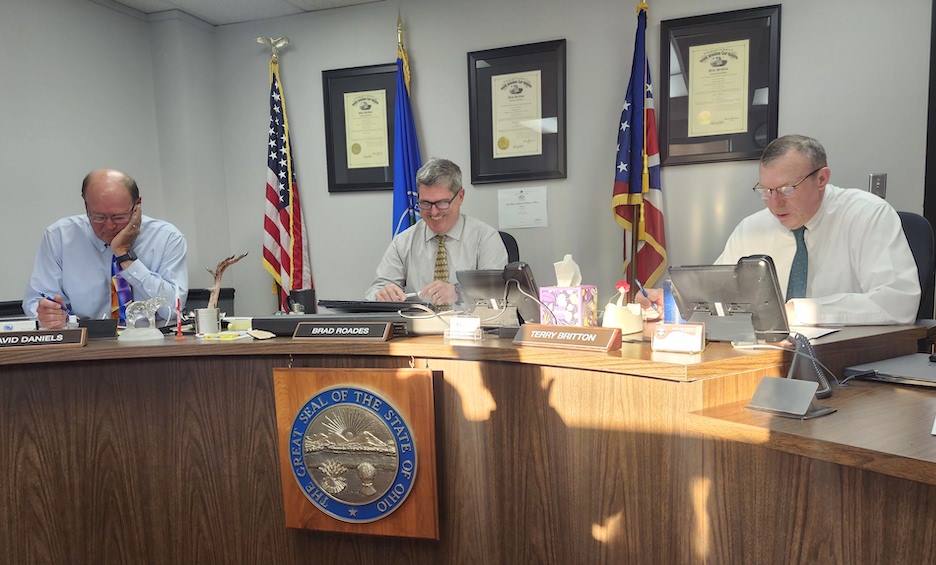Highland County Press: Developers recap Highland Solar construction, outline future plans at commission meeting

Article link: Developers recap Highland Solar construction, outline future plans at commission meeting
March 14, 2025
By Caitlin Forsha, The Highland County Press
For a second straight week, Highland County commissioners Brad Roades, Terry Britton and David Daniels received updates on a local solar project, as their March 12 meeting involved discussions of construction statistics and future planning for the recently commissioned Highland Solar project.
Attending the meeting to provide an update were Jared Wren, Senior Manager, Development & Stakeholder Engagement of Hecate Energy, the developer for the project; and regional manager Connor Cox and development associate Maria Smith-Lopez of DESRI (DE Shaw Renewable Investments), the company assuming operations of the project. Kevin DeWine was also in attendance.
As previously reported, the 300 MW Highland Solar project, located in Clay and Whiteoak townships, began commercial operation on Oct. 24, 2024.
“Primarily, the construction activities are completed at this point,” Wren said.
However, he noted that they are not quite done with the existing parcels for the solar project, as plans are underway for an additional 230-megawatt project, Nuthatch Solar. Wren said the project is already “qualified” under Senate Bill 52 and would be a “final phase” of their New Market/Highland Solar development.
“It’s still being finalized in terms of its project footprint,” Wren said. “It will comprise acreage that is already in and among this project area, either adjoining or ground that was not part of either the first two phases, but was contemplated. It will be sort of the final stage of the development of this community, and we will bring it forward in due course, following the new OPSB [Ohio Power Siting Board] 90-day notification process and do preliminary meetings prior to that.
“We’ll have more as we get closer to that process and really ramp up the engagement around that project.”
Wren added that they and other developers “can continue to develop projects on less ground, but still reach megawatt thresholds that are higher than just even a couple of years ago based on the modules.”
In response to a question from Daniels, Wren said the eventual Nuthatch Solar project, the Highland Solar project and the New Market Solar project (which is now owned by Algonquin Power) “will all have a shared, centrally co-located point of interconnection where they all jump into the Clay substation.” Cox and Smith-Lopez said it would be “basically the same team” working on Highland and Nuthatch Solar’s operations and maintenance, but with several other staff members added.
Now that the Highland Solar project is up and running, Cox said staff from DESRI and SOLV Energy — “the engineering procurement construction company that built the project for us” — will be onsite monitoring operations and performing needed maintenance daily.
“Now on site, we have five site technicians, and then they have regional managers up through the SOLV Energy operations and maintenance chain,” Cox said.
The three solar representatives took turns sharing information the current project, with a look back at construction and an overview of Highland Solar’s impact on the local economy and on the climate.
“We have some sort of highlights, just general economic numbers, that show the story of this project and its investment and what it means economically to the community during the construction period and now into operation,” Wren said.
A “by the numbers” look at the statistics shared by Wren, Cox and Smith-Lopez included:
• Construction for the project involved 1,185 workers, 82-percent domiciled in Ohio; 3,748 deliveries; and 724,887 man hours over the course of 30 months.
• The construction process included installing 744,549 panels; 84 inverters; 449 tracker motors with a 52-degree range of motion; 184,430 feet of AC trench cabling; 553,290 total feet of AC cabling; 255,948 feet of DC above-ground cabling; 49,100 feet of DC underground cabling; five weather stations; and 119,149 steel piles driven.
• New internal site roads constructed total 50,810 feet, involving 492,156 cubic yards of gravel.
• The environmental benefits to the project are equivalent to 136,202 gasoline-powered passenger vehicles taken off the road for one year; 424,484 electric-powered passenger vehicles taken off the road for one year; 1,486,977,816 miles not being driven by an average gasoline-powered passenger vehicle; 65,704,554 gallons of gasoline not being consumed; 648,623,003 pounds of coal not being burned; 3,237 railcars’ worth of coal not being burned; or 1,351,890 barrels of oil not being consumed.
“In terms of avoidance impacts, it’s very high,” Smith-Lopez said.
• The project’s Payment in Lieu of Taxes (PILOT) will begin in 2026 at a rate of $9,000 per megawatt, or $2.7 million annually, benefiting the county as well as Whiteoak and Clay Townships, Bright Local and Lynchburg-Clay Local school districts and other area entities.
“We’re excited to start making those payments soon enough and start contributing to the community here,” Smith-Lopez said.
Until then, developers are continuing to pay property tax on the parcels, Wren added.
“I think we’ve made over a half million in property taxes since we purchased that land, so we already do have dollars flowing into the community, but the real dollars will happen with that PILOT agreement,” Smith-Lopez said. “We look forward to that happening.”
In other construction-related discussion, Cox said that developers have satisfied their Road Use Maintenance Agreement (RUMA) requirements with the Highland County Engineer “to ensure that all necessary road repairs are agreed upon and performed to fulfill our obligations.”
Additionally, Cox told commissioners that developers are “working closely with” the Ohio Power Siting Board to implement vegetation management practices.
“We have hired a different vendor than was used by SOLV during construction, so they’re very familiar with the site,” Cox said. “Moving forward, we anticipate a lot better management and care of the vegetation around the site.
“The plans for the site in the first few years, it may need more mows than kind of further-out years just due to kind of knocking down any weed growth, anything like that.”
In the future, Cox said they may use sheep and/or cows “as a supplement to mechanical methods” for regulating vegetation growth. He added that the area is “enclosed in an eight-foot-high game fence,” and Roades asked about the company’s “responsibility on the outside of the fence … along the roadways.”
“The vegetation contractor will be keeping those up at the same frequency as the county would, for county roads,” Cox said. “Around other portions of the project, we tend to do a kind of 15- to 25-foot kind of buffer firebreak, just so that if there were to ever be a brush fire or anything, nothing could get in the site, nothing could get out of the site.”
Wren also discussed the Clay substation “owned by AES there along Gath Road.
“It’s a 345-kV substation that is a highly modernized and robust substation that further bolsters the local grid,” Wren said. “Those kind of infrastructure investments are why these projects were here in the first place when the transmission lines were run. I think those kind of generational upgrades that are the burden of the project, not the burden of the community, are also kind of ancillary, second-tier benefits of the development activities around the community.”
Also moving forward, Wren told commissioners they could expect to see Hecate and DESRI staff continuing to “support development activities in the community.
“One of the criticisms we heard were ‘you guys are going to disappear and we’re never going to see you again,’” Wren said. “I think it’s very important, both as a project and as companies, as DESRI and Hecate, that we make sure that this project and future phases are good corporate citizens, good neighbors to the people that we’re developing around.”
On a related note, Daniels asked “what the maintenance and operation of this facility looks like going forward” over the anticipated 30-year life of the project.
Cox said in the early stages of the project post-construction, SOLV Energy’s maintenance and operations crew is “working the kinks out,” but they will continue to perform regular work on the site.
“They have annual preventative maintenance that they do, and then at the substation, they have longer, every five-year, kind of more significant maintenance that they do, and then addressing any issues that arise,” Cox said. “They’re trained on everything from the inverters, the trackers, replacing modules if and when any break or need to be replaced, and then all the way up to working on the substation.”
Roades asked if the crews will continue working on site “for the next 30 years,” and Cox said the project will continue to have a full-time technician on site five days a week.
“If an inverter were to kind of go down with a fault over a weekend, they’ll dispatch and get that back running it to service,” Cox said. “In terms of the control, it is monitored 24/7 from a state-of-the-art control facility actually out in San Diego.”
Daniels asked if “switching out panels” on the existing site as they begin “losing some efficiency” is an option years into the future, “so that you’re not out acquiring new land.”
“Generally, when we think about decommissioning, we kind of view these projects as modular,” Wren said. “he amount of cabling and steel that exists in the ground that can be essentially repowering, or these panels can be replaced with higher-wattage modules. You can actually end up shrinking the overall footprint of the project over the life of it through repowering.
“We intend these projects to live through their useful life and then be able to repower them and to, as you described, not have to decommission and pull out and return the site to its natural state, to continue on that investment and leverage it again for another useful life of a project, ultimately, and all the tax benefits associated with a new project would ultimately recycle.”
Cox added that DESRI would do a “cost benefit analysis” to determine best options in the future.
Daniels also asked if he could have an “in-depth look” at the facility, with Roades agreeing, as they said it would help them better answer questions from the community. The developers said they could arrange a tour.determine best options in the future.
After meeting with commissioners, the developers said they were going to speak with leaders of Bright Local and Lynchburg-Clay Local Schools for updates on both the project and the PILOT. The group thanked commissioners for adding them to the agenda.
“We’re just excited to talk about this coming to fruition, the hundreds of thousands of solar panels and the steel and aluminum and glass coming largely from this part of the world, utilizing Ohio-based workforce, is really the story of this development and this community,” Wren said. “We’re thankful for your commitment to the process and holding us accountable, holding an industry accountable, to do what we say we’re going to do, and make sure that the contracts are coincide with that.”

